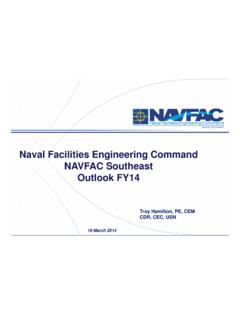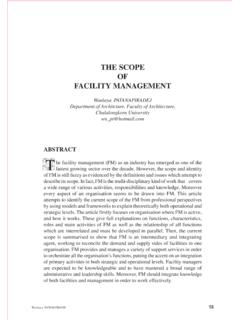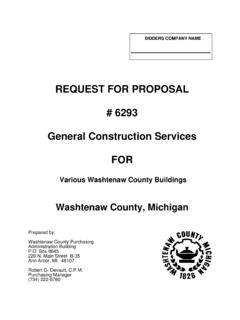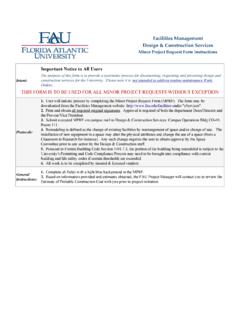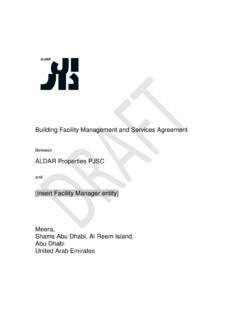Transcription of Strategic Facility Planning - IFMA
1 International Facility management AssociationStrategic Facility Planning : A WhIte PAPer Strategic Facility Planning : A White Paper on Strategic Facility Planning 2009 | International Facility management AssociationFor additional information, contact:1 e. Greenway Plaza, Suite 1100houston, tX 77046-0104 USAP: +1-713-623-4362F: + OF cOntentSPreFace ..2executive Summary ..3 Overview ..4 DeFinitiOn OF Strategic Facility Planning within the Overall cOntext OF Facility Planning ..5 SPecializeD analySeS ..9 OrganizatiOnal aPPrOacheS tO SFP .. 10the SFP PrOceSS ..11 understanding ..11 analysis ..12 Planning ..15 action ..16the SFP PrOceSS mODel (Figure) ..17 DeFinitiOnS ..19 Strategic Facility Planning : A White Paper International Facility management Association2 Strategic Facility Planning : A White PaperIn the real world of Facility management (FM), a plethora of activities fall under the Facility manager s responsibility, causing frequent lapses into a reactive mode in order to respond to all the requests, orders, regulations, deadlines and demands of the organization.
2 Facility managers know that the need to become more proactive and Strategic is important, but finding the time to devote to Strategic Planning is often a struggle. As Stephen Covey teaches, we need to prioritize what is important rather than simply urgent in order to gain maximum Facility Planning (SFP) is a process that can lead to better, more proactive delivery of services from a Facility management organization to its stakeholders. the time taken to carry out SFP is well spent in that it helps to avoid mistakes, delays, disappointments and customer dissatisfaction. It can actually allow Facility plan implementations to run more quickly and SFP is not a daily task, many Facility managers are unfamiliar with the best way to accomplish this type of Planning , or perhaps have been asked by senior management to quickly provide a Strategic Facility plan and are not sure where to start.
3 Facility managers may still be unsure how to initiate the SFP process and need to obtain information on methods and techniques useful for successfully implementing a SFP to correspond with their organization s needs. While every organization is different, all organizations strive to become more competitive, effective and provide the best workplace possible for its employees. This is the role Facility managers fulfill and SFP is an exercise that is considered another tool to add to the FM tool belt needed for white paper provides information on the SFP process, its requirements and benefits, and gives a Facility manager the basic tools to launch and successfully complete a SFP for the supported organization. Definitions are provided in an appendix to help clarify terms quickly or for reference.
4 A process model is also provided to support visual thinkers and learners. PreFaceProfessor Kathy O. roper, CFM, CFMJ, LeeD AP, IFMA Fellow and associate professor of Integrated Facility management at Georgia Institute of technology in Atlanta, Ga., and Candidates Jun ha Kim and Sang-hoon Lee, of Georgia tech, assembled this white paper for the International Facility Manage-ment Association (IFMA). We would like to thank IFMA Chair John McGee for his input and review, and IFMA President and CeO David J. Brady for his support on this project and allowing Georgia tech to par-ticipate in this work. Mark Sekula, CFM, LeeD AP and William rodgers were also part of the task force to review, amend, gain IFMA board of directors approval and finalize this | international Facility management association | 2009this white paper outlines the key principles of Strategic Facility Planning and details the key stages of the entire SFP process, which consists of understanding, analyzing, Planning and acting.
5 Facilities are the critical components of an organization s SFP since they are the outcome of business decision-making processes and have a long-term impact on the support for achievement of the organization s mission and vision. Linking facilities to core business strategies is one of the imperatives of refined Facility management now and in the future. even greater importance will be given to SFP in coming years as budgets continue to be squeezed and worker performance and productivity are key factors in the knowledge age. SFP facilitates the organization s strategy by optimizing facilities to satisfy the Strategic relationships between the organization, products/ services and SFP is a two-to-five year plan encompassing the entire portfolio of owned and/or leased space that sets Strategic Facility goals based on the organization s Strategic objectives.
6 SFP helps Facility managers do a better job and ensures that all employees are working toward the same goals and objectives. A flexible and implement-able SFP based on the specific and unique considerations of your organization needs to be developed through a four-step process. The first step, understanding, requires thorough knowledge of your organization s mission, vision, values and goals. Second, exploration of the range of possible futures and triggers is needed to ana-lyze your organization s Facility needs using analytical techniques such as systematic layout Planning (SLP), strengths, weaknesses, opportunities and threats analysis (SWOt), Strategic creative analysis (SCAN), or sce-nario Planning . third, once analysis is completed, plans for potential responses and periodic updates to existing plans in response to changes in the market need to be developed to meet the long-range needs of your specific organization.
7 Fourth, take actions as planned to successfully implement the SFP. The SFP identifies the type, quantity and location of spaces needed by the organization and contains two main components the first being an in-depth analysis of existing facilities, and the other an achievable and afford-able plan to meet the organization s needs. Using the organizational business plan, the differences should be identified between the current situations and analyzed needs. Gap analysis a business resource assessment tool enabling an organization to compare its actual performance with its potential performance is an appro-priate tool to be used. Financial analysis is also required to determine the yield on highest return at the lowest risk. A proactive approach to benchmark practices and services of leading organizations in the industry will be helpful for SFP and serves as a mechanism to understand, analyze and improve the current facilities operation.
8 Since differences in organizational type, culture and processes strongly influence how SFP is accomplished, the recommended SFP will need to be adjusted in accordance with the different type, culture and processes of your specific Summary4 Strategic Facility Planning : A White PaperOverviewStrategic Facility Planning recognizes that every decision made in business Planning has a direct impact on an organization s real estate assets and needs. the purpose of the SFP plan, therefore, is to develop a flexible and implementable plan based on the specific and unique considerations of the individual business. A four-step process, shown in Figure 1, provides the general format to accomplish this Under-standingPlanningAnalysisActing Figure 1. SFP Four-step Processunderstandingthoroughly understand the organization s mission, vision, values and goals.
9 Many organizations follow a balanced scorecard of four key measurements: financial performance; customer knowledge; internal business processes; and learning and analytical techniques, such as SWOt analysis, SCAN, SLP or scenario Planning , to explore the range of possible futures and the triggers used to analyze an organization s Facility plans that meet the long-range needs of the organization. At minimum, the SFP should be reviewed annually and further updated periodically as conditions require. actingtake actions as planned and implement the SFP. Feedback from actions taken can be incorporated into the next plan and/or project to provide continuous improvement to future SFPs. the cyclical nature of constant Planning for the changing future and adopting plans along the way are normal events.
10 These changes and updates must be managed to ensure they are achievable. 1 John r. Glagola (2002) An Introduction to Strategic Facilities Planning , Real Estate Issues 27(1): | international Facility management association | 2009 DeFinitiOn OF Strategic Facility Planning within the Overall cOntext OF Facility PlanningThe Strategic Facility Planning process can be defined as the process by which a Facility manage-ment organization envisions its future by linking its purpose to the strategy of the overall organiza-tion and then developing goals, objectives and action plans to achieve that future. the result of the Strategic Facility Planning process is the Strategic Facility , in its Project management Benchmarks Survey 2002, defines the Strategic Facility plan: A Strategic Facility plan (SFP) is defined as a two-to-five year facilities plan encompass-ing an entire portfolio of owned and/or leased space that sets Strategic Facility goals based on the organization s Strategic (business) objectives.



